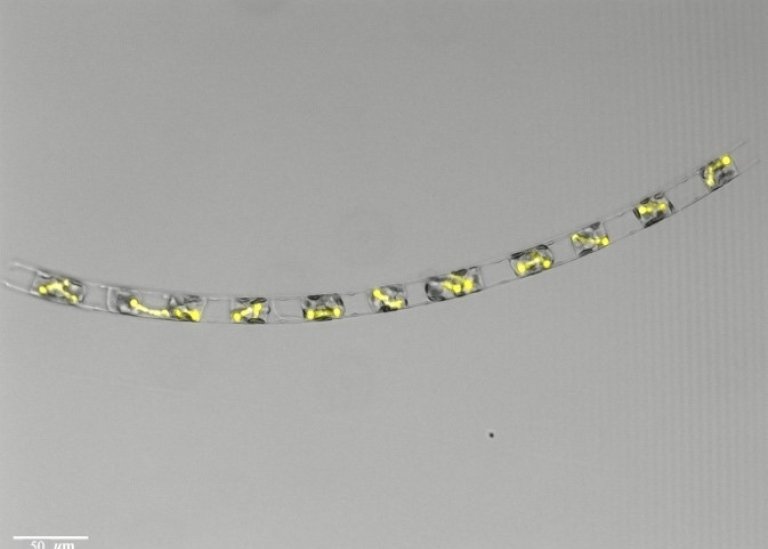Link to published article, PNAS Nexus, Volume 2, Issue 6, June 2023, pgad194,: https://academic.oup.com/pnasnexus/article/2/6/pgad194/7205781
Authors: Mercedes Nieves-Morión, Sergio Camargo, Sepehr Bardi, María Teresa Ruiz, Enrique Flores, Rachel A Foster
Link to Stockholm University Press Release: https://www.su.se/department-of-ecology-environment-and-plant-sciences/news/microalgae-fuel-their-nitrogen-fixing-partners-and-thrive-together-in-the-nutrient-deplete-sea-1.661989
From Stockholm University Press Release, June 28 2023:
“Microalgae fuel their nitrogen fixing partners and thrive together in the nutrient deplete sea
A type of microalgae, diatoms, have long been recognized as significant contributors to global primary production; responsible for one fifth of this vital process. Most diatoms live in coastal regions with high nutrients. However, a few have successfully invaded open ocean, regions where dissolved nutrients, particularly nitrogen, are below analytical detection. How? By forming partnerships, or symbiosis, with nitrogen fixing cyanobacteria. Cyanobacteria perform plant-like photosynthesis and some can fix di-nitrogen (N2) gas. N2 fixation is the process that takes di-nitrogen (N2) which comprises approximately 78% of our atmosphere to a biologically available form.
These populations are major players in the global nitrogen and carbon cycles, and since large areas of our oceans are nitrogen depleted, the activity of these symbioses provides a major input of new nitrogen to the ecosystem. Thus it is important to understand how the symbionts maintain high rates of nitrogen fixation. To date it is known that the cyanobacteria partners fix N2 and transfer to their host microalgae diatom, but how the diatoms help their symbionts has been largely unstudied.
Light micrograph of a chain of the Hemiaulus-Richelia symbioses imaged under white light and epifluorescence which excites and easily distinguishes the autofluorescence of Richelia filaments (here yellow). Typically, two Richelia filaments are found in one host Hemiaulus. Image taken by co-author and PhD candidate, Sepehr Bardi.
Light micrograph of a chain of the Hemiaulus-Richelia symbioses imaged under white light and epifluorescence which excites and easily distinguishes the autofluorescence of Richelia filaments (here yellow). Typically, two Richelia filaments are found in one host Hemiaulus. Image taken by co-author and PhD candidate, Sepehr Bardi.
In this study, Foster and colleagues collected wild populations of a diatom Hemiaulus hauckii along with its symbiotic cyanobacterium Richelia euintracellularis (hereaf ter Richelia) from water samples in the western tropical North Atlantic Ocean. Since it is currently impossible to grow the symbiosis in culture, Foster teamed up with Enrique Flores’ research team from Instituto de Bioquímica Vegetal y Fotosíntesis (Seville, Spain) to explore the function of several of Richelia’s proteins by expressing them in model organisms.
One protein was identified that splits sucrose into glucose and fructose. A sucrose-specific solute binding protein was also found that shuttles molecules across the cell membrane. Other solute binding proteins were confirmed that function in amino acid (glutamate, phenylalanine) and polyamine (spermidine) transport. The expression of all the genes that encode for these proteins was verified in the samples collected in the Atlantic Ocean. Collectively, the work provides the first evidence of how the diatom is supporting its cyanobacterial symbiont Richelia with reduced organic carbon compounds.
Foster reflects, “Until now we could largely only speculate about the interactions of the host and symbiont and compare to other model systems e.g. terrestrial plant-N2 fixing systems, for example soy-bean-Rhizobia. Collaborating with Flores group opened up a whole new toolbox. Using classical gene expression methods allowed us to circumvent the need for cultures, which this in itself is new to the field of microbial oceanography. So, in many ways our work lays the foundation for other important microbes many of which are unculturable. But really for me, what is most exciting is the insights we have gained into these symbioses as to the importance and function of the host….this has been a major black box.““
